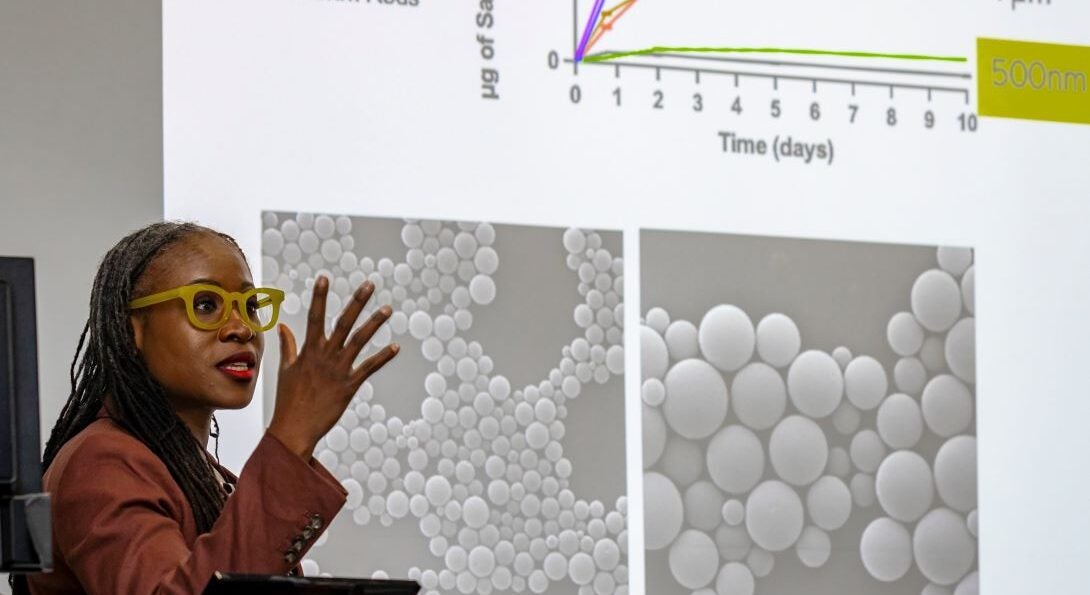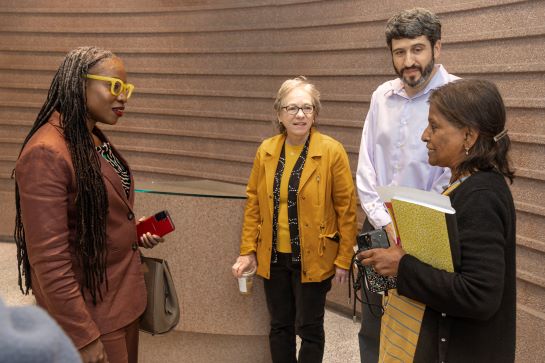Dean Lola Eniola-Adefeso presents blend of engineering and medicine at IFRM inaugural seminar

Text block one
Today’s urgent scientific challenges require innovative solutions that can only be achieved through interdisciplinary collaborations.
Newly appointed UIC College of Engineering Dean Lola Eniola-Adefeso exemplifies that approach by applying her engineering background to major medical challenges. Her expertise in designing new particles and biomaterials for drug delivery made her the ideal inaugural speaker for the Institute of Functional and Regenerative Materials seminar series.
The institute is one of four pilot institutes launched by the Office of the Vice Chancellor for Research in 2023 and consists of faculty from the colleges of engineering, liberal arts and sciences, dentistry, pharmacy, and medicine. This multifaceted team is working to accelerate, advance, and apply the discovery of materials with direct applications to improving our lives, environment, and health.
The seminar series is part of the IFRM’s mission to build collaboration across disciplines. The first installment highlighted the value of approaching medicine through an engineering lens with Eniola-Adefeso’s research on targeted, anti-inflammatory particle therapeutics.
Eniola-Adefeso found that using a targeted delivery system with nanoparticles was effective for drug delivery in the bloodstream. “Nano” means one-billionth; the smallest nanoparticles are tens of thousands of times smaller than a single strand of human hair. These nanoparticles can be used to recognize disease expressions and deliver drugs to specific targets. She compared this process to targeting the zip code.
“Every one of us has a five-digit ZIP code,” she explained, “but if you look closely in your mail, you see an extra four digits, and those extra four digits are the identification of your particular house. So, we can build that kind of unique patterning. Then we can design drug delivery vehicles that are targeted to find those specific patterns.”
Text block two

Eniola-Adefeso talked about how engineering principles helped her team solve biomedical problems from a unique perspective. Understanding flow and forces was integral to this project.
“It became a very interesting engineering question for us.” Eniola-Adefeso shared. “How do particles navigate the bloodstream, and how do they localize to the blood vessel? And when they do get to the wall, do they have enough adhesion forces to bind at the location that we need and hold on to that binding so that they can release the drug?”
Integrating medical and engineering concepts in her research continued to prove essential as they noticed immune system cells called neutrophils ripping their particles from blood vessel walls. This development changed the direction of their research.
“It was the first time in our engineering world where we were forced to remember that blood is a living machine and that there are cells of a variety of sizes and shapes in blood that have functions,” Eniola-Adefeso said.
Neutrophils are the body’s “first responders” and are responsible for preventing infection by capturing and ingesting harmful particles. While neutrophils are essential for a healthy immune system, when the body’s immune system becomes overactive and produces an excess of neutrophils, they can end up damaging healthy tissue. This has been seen with many COVID-19 patients, where high levels of neutrophils are closely linked to damage to the lungs and more severe prognoses.
The team decided to leverage the neutrophils’ defensive properties to mitigate their damaging impact on certain diseases. They designed particles to bind to the blood vessel wall, interfering with the neutrophils’ adhesion abilities. They also developed a protective coating for their particles with anti-inflammatory properties, including the active ingredient in aspirin, salicylic acid. When neutrophils ingested and degraded these particles, it released the drug, reducing their inflammatory mechanisms and the damage it caused.
They also found that particle shape influenced neutrophil behavior. Neutrophils preferred ingesting rod-shaped particles rather than spheres. Building upon these findings, they were able to develop anti-inflammatory particles that could be ingested by neutrophils and were more effective in preventing neutrophil adhesion.
“Can we outperform neutrophils?” She asked, when considering the design of her particles. “The answer is yes.”
Eniola-Adefeso’s lab has developed particles from other types of drugs, including steroids and deoxycholic acid, which can help reduce fat. In addition to white blood cells, they are also studying red blood cell activity in relation to malaria and sickle cell disease.
Eniola-Adefeso also leads the Humanity Unlocking Biomaterials Coordinating Center’s annual meeting, which will be held on April 7-8, 2025, in Chicago. Faculty will have opportunities for $100,000 pilot grants, networking, and additional resources. Students will have access to internship opportunities and networking.
In addition to the seminar series, the IFRM will hold its first workshop this January on functional and regenerative materials. The event will feature invited speakers from across Chicago and the country, a poster session for student researchers, and a stakeholder meeting for those interested in pursuing research opportunities and grants in partnership with the IFRM. Learn more and RSVP.